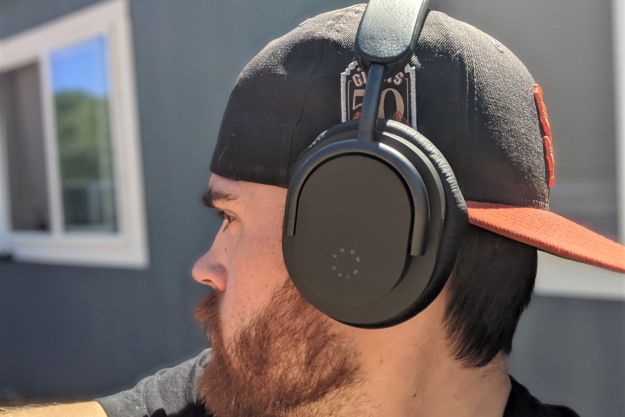
“The Calm aren't as different as they wanted to be, but they're still solid headphones.”
- Welcoming design
- Good battery life
- Clear, palatable sound
- Impactful active noise cancellation
- Inconsistent touch controls
- Special features don't stand out
Know has hit the wearable sound scene with an unusual focus: These aren’t just headphones for music, the company will tell you, but are meant to be tools for knowledge above all else, with features and a design made for the long-term listening that accommodates podcasts and audiobooks.
It’s a bold strategy to stand out among a group of quality headphones, and it only pays off if Know can back up its claims with a quality pair of cans. With its $250 Calm active-noise canceling headphones on hand (ear?), we are going to answer this question: Are these new headphones are worth it?
Out of the box
When you open as many product packages as I do on a regular basis, it tends to get rather monotonous. With headphones, there’s going to be a carrying case or pouch, a charging cable, maybe a 3.5mm auxiliary cable, and definitely an excessive amount of reading materials. If you’ve seen one, you’ve seen them all.
Or so I thought.

It’s a refreshing sight to encounter packaging like the one the Know Calm headphones come in. Yes, all those standard accessories are included, but they’re tucked into the box with a sense of creativity that I haven’t seen all that often with headphone companies. Plus, for whatever reason, Know includes both a notepad and an art piece in the mix, making it almost closer to a goodie bag than a collection of operating tools. I’m not saying every company should follow this out-of-the-box packaging style, but I am saying that it piqued my curiosity before I even powered on my pair of Calm cans.
When I did power them on, a very casual, non-robotic feminine voice let me know that the headphones had automatically entered pairing mode. After finding and connecting them to my phone, the same nonchalant voice told me that my device had been paired in the same tone that a baker would use to tell my order of donuts was ready on a quiet morning downtown. In other words, it’s the calming presence you would expect from a pair of
The Know Calm are like most other headphones I’ve tried, in that they have Bluetooth 5 technology built-in, which at this point means I expect them to be free of pairing issues and full of range. Both rang true yet again, with the Calm surviving the venture into my backyard and back without dropping out.
Design
I don’t normally talk about the carrying case first, but I’m going to make an exception here. The case for the Calm more closely resembles a comforter for a luxury bed than it does a protective shell for headphones, and I mean that in a good way. The case is soft yet durable, with an external pocket that I would assume would easily house any cables you may need to bring with you. With a buckle on the backside of the case for securing it to backpacks or luggage as a bonus, this really seemed like one of the better soft carrying cases for

The Calm are available in Black, Sage, or Plum Gray. The ear cups and headband are both welcoming and comfortable on your head, so much so that I was able to enjoy nearly a full day of consistent listening without feeling any kind of fatigue that less friendly headphones might evoke. And, in what I’m finding to be true Know fashion, the inside of the left and right cups read “Left ear” and “Right ear,” as opposed to the traditional L or R. We’re talking about small, mostly inconsequential details here, but it’s something that shouldn’t go unnoticed. Every step of the way, Know seems to be making a conscious effort to set themselves apart. So far, it’s working.
Every step of the way, Know seems to be making a conscious effort to set themselves apart. So far, it’s working.
I do not, however, much like the controls of the Know Calm. Outside of the power/pairing button and the noise-canceling button, both of which work as intended, the majority of the controls for the Calm come via touch controls on the right earcup. To be fair, some of the commands worked well, like swiping forward and back to change tracks, and I think these controls are usable overall. But it was certainly an annoyance to deal with inconsistent responses to trying to pause a track or turn down the volume. It could just be that my fingers just aren’t well-suited for the Calm’s touch sensors, but it was irritating either way. By comparison, the Razer Opus has buttons for each of these commands, which was personally a far easier way to operate than the process of hoping your touches are interpreted correctly.
Features
Know claims up to 24 hours of playback on a full battery charge, which is decent enough in this price range. That’s better than the Microsoft Surface Headphones 2, which are priced exactly the same, and on par with the cheaper Razer Opus. There are budget cans like the JLab Audio Studio ANC that have better battery life, but you’re losing a lot of other perks along the way. That said, 24 hours for the Know Calm seems fair at this price point.

Staying on the topic of battery life, the Calm can be charged from a Qi-certified wireless charging pad. That’s not included, but you can still use the USB-C charging cable that is tossed in. Either way, Know says you can get three hours of playback after five minutes on the charger. Again, that’s better than the Surface Headphones 2, the same as the Beats Solo3 Wireless, and potentially rivals the Sony WH-1000XM4, which gives you five hours of playback after 10 minutes of charging.
Know does make up for the irritating control problem in part by including compatibility with Siri for Apple users and Google Assistant for Android fans. I can simply say “Hey, Google,” and enact any of the commands I might have had minor trouble with by using the Calm’s touch controls. I still think the touch controls should be refined to be as easy as possible to use, but having the ability to make my smart assistant do my bidding bridges the gap well enough for now.
The Calm also come equipped with a sensor that will auto pause and play when you take them off and put them back on. I caught them resuming playback while they were still around my neck a couple of times, but for the most part, this was a useful inclusion to these headphones that worked well.
Audio quality
Know has an intriguing technology it calls “Mindshine technology.” Basically, this feature processes audio to try and imitate how your ears naturally process sound. According to Know, instead of your ears having to adapt to a simultaneous wave pattern, the sound bounces around your head to create the effect of hearing it in the same way you might hear something from an external source.

It’s not easy for me to decipher how much weight this technology holds when comparing the sound quality of the Calm to similar headphones. With some selections, it seems more tangible, and with others, it’s hard to distinguish. The truth of the matter is, it might not really matter: regardless of how much that tech might or might not play into the sound quality of the Calm, these
I would put these headphones side-by-side with comparatively priced alternatives like the Razer Opus in terms of how they sound. The Calm are remarkably clear and provide a great sense of stereo separation when playing songs like The Doobie Brothers’ Listen to the Music. Of course, part of Know’s pitch is that the Calm are
The Calm are remarkably clear and provide a great sense of stereo separation.
I don’t think the Calm are the budget alternative to the Sony WH-1000XM4 when it comes to sound, though it’s understandably tough for most headphones at this price point to try and compete with that juggernaut and given they’re much cheaper, they probably shouldn’t. That said, I do think the Calm offer solid audio quality for what they cost, and I don’t think anyone will be disappointed about how these
Active noise cancellation
In addition to its Mindshine Technology, Know has another piece of technology that I hadn’t previously heard of. It’s called Hush Active Noise Cancellation, which Know says is the first ANC tech to “tackle noise in the mid-high frequency range, as well as the low-frequency range that legacy ANC headphones handle.”

I can’t comment on this being the first technology to put both ends of the frequency range in its crosshairs, but here’s what I can say: After testing the Calm in several different environments, these headphones have above-average, impactful active noise cancellation. I’m not exactly in a position to take a flight during the current climate of the world, so I didn’t get a chance to see how the Calm reacted to plane engine drones or other low frequencies, but with socially-distanced walks in the park and down busy roads, these
These headphones did very well when it came to blocking out neighboring conversations and unwanted traffic noise.
There are three settings available with that active noise cancellation button – low, high, and off. Plus, you can cup your hand over the right earcup to amplify outside noises if you want to quickly talk to a passerby, pretty much exactly the feature we see in the Sony XM4s. It’s a slightly awkward gesture, but it works well and rounds out an effective active noise canceling ensemble. Not up to Sony standards, to be clear, but these days, who is?
Our take
With its Calm headphones, Know made pointed choices with several details and design aspects to help set its cans apart from the pack. Functionally, there’s nothing that blows competitors completely out of the water, so I can’t say they succeed in that endeavor. But the Calm are solid
Are there better alternatives?
For strictly music listening, I might opt for the Razer Opus since it’s got similar features for $50 less. But if you’re regularly listening to more than just tunes, I think I’d prefer the clarity of the Calm. Or, you could spend an extra $100 and get the best headphones available today, the Sony WH-1000XM4.
How long will they last?
Know has a one-year limited warranty, as well as a 45-day guarantee that you’ll love these headphones or your money back. The company is confident that these
Should you buy them?
Yes. My unboxing of the Know Calm headphones gave me hope that these would be different than anything else I’ve tested. Though testing dampened the reality of that idea, it still proved that these
Editors' Recommendations
- Sony WH-1000XM6: the design and features we want Sony’s next headphones to deliver
- Best wireless earbuds for 2024: Sony, Bose, Soundcore, and more
- Best Bose 700 deals: Save $151 on the wireless headphones today
- Best Bose QuietComfort Ultra deals: Save $50 on the headphones
- Best headphones for 2024: Sony, Bose, Apple, and more




